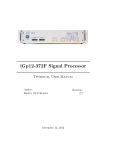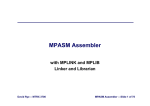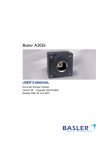Download Basler A202k User`s manual
Transcript
USER’S MANUAL SUPPLEMENT Document Number: DA00073602 Release Date: 4 April 2006 For customers in the U.S.A. This equipment has been tested and found to comply with the limits for a Class A digital device, pursuant to Part 15 of the FCC Rules. These limits are designed to provide reasonable protection against harmful interference when the equipment is operated in a commercial environment. This equipment generates, uses, and can radiate radio frequency energy and, if not installed and used in accordance with the instruction manual, may cause harmful interference to radio communications. Operation of this equipment in a residential area is likely to cause harmful interference in which case the user will be required to correct the interference at his own expense. You are cautioned that any changes or modifications not expressly approved in this manual could void your authority to operate this equipment. The shielded interface cable recommended in this manual must be used with this equipment in order to comply with the limits for a computing device pursuant to Subpart J of Part 15 of FCC Rules. For customers in Canada This apparatus complies with the Class A limits for radio noise emissions set out in Radio Interference Regulations. Pour utilisateurs au Canada Cet appareil est conforme aux normes Classe A pour bruits radioélectriques, spécifiées dans le Règlement sur le brouillage radioélectrique. Life Support Applications These products are not designed for use in life support appliances, devices, or systems where malfunction of these products can reasonably be expected to result in personal injury. Basler customers using or selling these products for use in such applications do so at their own risk and agree to fully indemnify Basler for any damages resulting from such improper use or sale. Warranty Note Do not open the housing of the camera. The warranty becomes void if the housing is opened. All material in this publication is subject to change without notice and is copyright Basler Vision Technologies. Contacting Basler Support Worldwide Europe: Basler AG Ander Strusbek 60 - 62 22926 Ahrensburg Germany Tel.: +49-4102-463-500 Fax.: +49-4102-463-599 [email protected] Americas: Basler, Inc. 740 Springdale Drive, Suite 100 Exton, PA 19341 U.S.A. Tel.: +1-877-934-8472 Fax.: +1-877-934-7608 [email protected] Asia: Basler Asia Pte. Ltd 8 Boon Lay Way # 03 - 03 Tradehub 21 Singapore 609964 Tel.: +65-6425-0472 Fax.: +65-6425-0473 [email protected] www.basler-vc.com DRAFT Contents Table of Contents 1 Purpose of This Document . . . . . . . . . . . . . . . . . . . . . . . . . . . . . . . . . . . . . . . . . . . 1 2 Gain Changes . . . . . . . . . . . . . . . . . . . . . . . . . . . . . . . . . . . . . . . . . . . . . . . . . . . . . . . . 2 2.1 Larger Gain Range . . . . . . . . . . . . . . . . . . . . . . . . . . . . . . . . . . . . . . . . . . . . . . . . . . . 2 2.2 Left Side Gain and Right Side Gain Binary Commands . . . . . . . . . . . . . . . . . . . . . . . 3 3 Digital Shift Changes . . . . . . . . . . . . . . . . . . . . . . . . . . . . . . . . . . . . . . . . . . . . . . . . . 4 3.1 Additional Digital Shift Setting Available . . . . . . . . . . . . . . . . . . . . . . . . . . . . . . . . . . . 4 3.1.1 Digital Shift With 10 Bit Output . . . . . . . . . . . . . . . . . . . . . . . . . . . . . . . . . . . . . 4 3.1.2 Digital Shift With 8 Bit Output . . . . . . . . . . . . . . . . . . . . . . . . . . . . . . . . . . . . . . 6 3.1.3 Precautions When Using Digital Shift . . . . . . . . . . . . . . . . . . . . . . . . . . . . . . . . 8 3.2 Digital Shift Binary Command . . . . . . . . . . . . . . . . . . . . . . . . . . . . . . . . . . . . . . . . . . . 9 4 Pixel Clock, Timing Chart, and Frame Rate Formula Changes . . . . . . . 10 4.1 Calculating the Maximum Allowed Frame Rate Based on the AOI Size . . . . . . . . . 13 4.2 Calculating the Maximum Allowed Frame Rate Based on Binning . . . . . . . . . . . . . 13 5 Timer 1 and Timer 2 Binary Commands . . . . . . . . . . . . . . . . . . . . . . . . . . . . . 14 5.1 Timer 1 Binary Command . . . . . . . . . . . . . . . . . . . . . . . . . . . . . . . . . . . . . . . . . . . . . 14 5.2 Timer 2 Binary Command . . . . . . . . . . . . . . . . . . . . . . . . . . . . . . . . . . . . . . . . . . . . . 15 6 Exposure Control Recommendation Changes . . . . . . . . . . . . . . . . . . . . . . . 16 Revision History . . . . . . . . . . . . . . . . . . . . . . . . . . . . . . . . . . . . . . . . . . . . . . . . . . . . . . . i Feedback . . . . . . . . . . . . . . . . . . . . . . . . . . . . . . . . . . . . . . . . . . . . . . . . . . . . . . . . . . . . . . ii Basler A202k High Gain I Contents II DRAFT Basler A202k High Gain DRAFT 1 Supplement Purpose of This Document The Basler A202k High Gain camera is a variant of the standard Basler A202k camera. The purpose of this document is to describe the unique aspects of A202k High Gain cameras. The unique aspects of A202k High Gain camera are listed below. • As the name implies, A202k High Gain cameras have a higher available gain range than standard A202k cameras. The gain range and the gain related binary commands for high gain cameras are detailed in Section 3. • A202k High Gain cameras have more digital shift settings than standard A202k cameras. The digital shift settings and digital shift binary commands for high gain cameras are detailed in Section 4. • A202k High Gain cameras use a 36 MHz pixel clock rather than the 40 MHz pixel clock used on standard A202k cameras. This change means that: - The timing charts for the A202k High Gain are different from standard cameras. - The camera’s maximum frame rate at full resolution is 43 frames per second rather than 48 frames per second as on standard cameras. - The formulas for calculating the maximum allowed frame rate are different from standard cameras. - The meaning of the binary commands used to set Timer 1 and Timer 2 have changed. - The recommendations for controlling exposure in ExSync programmable mode and in Freerun programmable mode have changed. Section 5 shows the timing charts and the frame rate formulas for high gain cameras. Section 6 explains the change to the meaning of the Timer 1 and Timer 2 binary commands. Section 7 lists the exposure control recommendations for high gain cameras. In all other respects, the operation and features of A202k High Gain cameras are identical to the operation and features on standard A202k cameras. For a full description of an A202k High Gain camera and its capabilities, this document must be used together with the A202k User’s Manual (document number DA04400x). Basler A202k High Gain 1 Supplement 2 DRAFT Document Applicability This user’s manual supplement applies to A202k High Gain cameras with a camera version ID number of 02. High gain cameras with a lower or a higher ID number may have fewer features or have more features than described in this supplement. Features on cameras with a lower or a higher ID number may not operate exactly as described in this supplement. An easy way to see the camera version ID number for an A202k High Gain camera is by using the CCT+. To see the camera version ID number: 1. Double click the CCT+ icon on your desktop or click Start ⇒ All Programs ⇒ Basler Vision Technologies ⇒ CCT+ ⇒ CCT+. The CCT+ window will open and the software will connect to your camera. 2. Scroll down until you find the “Camera Information” group heading. If there is a plus sign beside the Camera Information group heading, click on the plus sign to show the list of parameters in the group. 3. Find the parameter called “Camera Version.” As shown in Figure 1, the last two numbers of this parameter are the camera version ID number. This is the camera version ID Number. Figure 1: CCT+ Window 2 Basler A202k High Gain DRAFT 3 Supplement Gain Changes 3.1 Larger Gain Range The major difference between the standard camera and the high gain version is the gain range. On standard cameras, the gain can be programmed on a decimal scale that ranges from 288 to 569 (0x0120 to 0x0239). At the highest gain setting on a standard camera, the gain will be 12 dB. On the high gain version, gain can be programmed on a decimal scale that ranges from 288 to 1023 (0x0120 to 0x03FF). The settings result in the following amplifications: Decimal Number (DN) Hexadecimal dB Factor 288 0x0120 0 x1 1023 0x03FF 28.06 x25 Table 1: Gain Settings on a High Gain Camera If you know the decimal number (DN) setting for the gain on a high gain camera, the equivalent decibel value can be calculated using the following equations: 658 + DN ⎞ ⎛ --------------------------- – 8.15 10 ⎝ 658 – DN ⎠ When DN setting = 288 ... 511 Gain in dB = 20 log When DN setting = 512 ... 1023 Gain in dB = .0354 (DN) – 8.15 L In normal operation, a gain setting lower than 288 (0x0120) should not be used. When the gain setting is lower than 288, the sensor output signal that is mapped to the input of the ADCs will not be linear. Basler A202k High Gain 3 DRAFT Supplement 3.2 Left Side Gain and Right Side Gain Binary Commands On high gain cameras, the data range for the left side gain and the right side gain binary commands is larger than on standard cameras. The larger range is shown in the tables below. Left Side Gain Purpose: To set the gain for the left side of the CCD array or to read the current left side gain setting. Type: This is a read or write command. Read Command: Response: Write Command: Response: Data Format: Data Range: Cmd-ID 0x80 R/W-Flag 1 Data Length 2 Data - Cmd-ID 0x80 R/W-Flag 0 Data Length 2 Data 2 Bytes Cmd-ID 0x80 R/W-Flag 0 Data Length 2 Data 2 Bytes None Byte 1 Low byte of left side gain setting Byte 2 High byte of left side gain setting Left side gain settings can range from 288 to 1023 (0x0120 to 0x03FF). Right Side Gain Purpose: To set the gain for the right side of the CCD array or to read the current right side gain setting. Type: This is a read or write command. Read Command: Response: Write Command: Response: Data Format: Data Range: 4 Cmd-ID 0x82 R/W-Flag 1 Data Length 2 Data - Cmd-ID 0x82 R/W-Flag 0 Data Length 2 Data 2 Bytes Cmd-ID 0x82 R/W-Flag 0 Data Length 2 Data 2 Bytes None Byte 1 Low byte of right side gain setting Byte 2 High byte of right side gain setting Right side gain settings can range from 288 to 1023 (0x0120 to 0x03FF). Basler A202k High Gain DRAFT 4 Supplement Digital Shift Changes 4.1 Additional Digital Shift Setting Available On standard cameras, the digital shift feature has “shift once” and “shift twice” settings available. On high gain cameras, a “shift three times” setting has been added. The description of the digital shift feature that appears below includes the additional setting. Digital Shift On High Gain Cameras The “digital shift” feature lets you change the group of bits that is output from each ADC. Using the digital shift feature will effectively multiply the output of the camera by 2 times, 4 times or 8 times. Digital shift works differently depending on whether the camera is set for 10 bit output or for 8 bit output. The digital shift description that starts on page 5 applies when the camera is operating in 10 bit output mode. The description that starts on page 7 applies when the camera is operating in 8 bit output mode. Page 9 describes precautions that you must observe to effectively use the digital shift feature. You can set digital shift using either the Camera Configuration Tool Plus or binary commands. With the configuration tool, you use the Digital Shift setting in the Output group to set digital shift. With binary commands, you use the Digital Shift command. 4.1.1 Digital Shift With 10 Bit Output No Shift The A202k High Gain camera uses 10 bit ADCs to digitize the output from the CCD sensor. When the camera is operating in 10 bit output mode with no digital shift, it simply transmits the 10 bits that are output from each ADC. Shift Once When the camera is set to shift once, the output from the camera will include bit 8 through bit 0 from each ADC along with a zero as an LSB. The result of shifting once is that the output of the camera is effectively doubled. For example, assume that the camera is set for no shift, that it is viewing a uniform white target, and that under these conditions the reading for the brightest pixel is 100. If you changed the digital shift setting to shift once, the reading would increase to 200. Basler A202k High Gain 5 DRAFT Supplement L Note that if bit 9 is set to 1, all of the other bits will automatically be set to 1. This means that you should only use the shift once setting when your pixel readings in 10 bit mode with no digital shift are all below 512. Since the shift once setting requires that the least significant bit always be "0", no odd gray values can be output. In this case, the gray value scale will only include gray values of 2, 4, 6 and so forth. The absence of some gray values is commonly called "Missing Codes”. Shift Twice When the camera is set to shift twice, the output from the camera will include bit 7 through bit 0 from each ADC along with two zeros as LSBs. The result of shifting twice is that the output of the camera is effectively multiplied by four. For example, assume that the camera is set for no shift, that it is viewing a uniform white target, and that under these conditions the reading for the brightest pixel is 100. If you changed the digital shift setting to shift twice, the reading would increase to 400. L Note that if bit 9 or bit 8 is set to 1, all of the other bits will automatically be set to 1. This means that you should only use the shift twice setting when your pixel readings in 10 bit mode with no digital shift are all below 256. Since the shift twice setting requires that the two least significant bits always be "0", the gray value scale will only include every 4th gray value. For example, 4, 8, 16 and so forth. Shift Three Times When the camera is set to shift three times, the output from the camera will include bit 6 through bit 0 from each ADC along with three zeros as LSBs. The result of shifting three times is that the output of the camera is effectively multiplied by eight. For example, assume that the camera is set for no shift, that it is viewing a uniform white target, and that under these conditions the reading for the brightest pixel is 100. If you changed the digital shift setting to shift three times, the reading would increase to 800. 6 Basler A202k High Gain DRAFT L Supplement Note that if bit 9, bit 8 or bit 7 is set to 1, all of the other bits will automatically be set to 1. This means that you should only use the shift three times setting when your pixel readings in 10 bit mode with no digital shift are all below 128. Since the shift three times setting requires that the three least significant bits always be "0", the gray value scale will only include every 8th gray value. For example, 8, 16, 24 and so forth. 4.1.2 Digital Shift With 8 Bit Output No Shift The A202k High Gain camera uses 10 bit ADCs to digitize the output from the CCD sensor. When the camera is operating in 8 bit output mode with no digital shift, it drops the least two significant bits from each ADC and transmits the 8 most significant bits (bit 9 through bit 2). Shift Once When the camera is set to shift once, the output from the camera will include bit 8 through bit 1 from each ADC. The result of shifting once is that the output of the camera is effectively doubled. For example, assume that the camera is set for no shift, that it is viewing a uniform white target and that under these conditions the reading for the brightest pixel is 20. If you changed the digital shift setting to shift once, the reading would increase to 40. L Note that if bit 9 is set to 1, all of the other bits will automatically be set to 1. This means that you should only use the shift once setting when your pixel readings in 8 bit mode with no digital shift are all below 128. Basler A202k High Gain 7 DRAFT Supplement Shift Twice When the camera is set to shift twice, the output from the camera will include bit 7 through bit 0 from each ADC. The result of shifting twice is that the output of the camera is effectively multiplied by four. For example, assume that the camera is set for no shift, that it is viewing a uniform white target, and that under these conditions the reading for the brightest pixel is 20. If you changed the digital shift setting to shift twice, the reading would increase to 80. L Note that if bit 9 or bit 8 is set to 1, all of the other bits will automatically be set to 1. This means that you should only use the shift twice setting when your pixel readings in 8 bit mode with no digital shift are all below 64. Shift Three Times When the camera is set to shift three times, the output from the camera will include bit 6 through bit 0 from each ADC along with a zero as the LSB. The result of shifting three times is that the output of the camera is effectively multiplied by eight. For example, assume that the camera is set for no shift, that it is viewing a uniform white target and that under these conditions the reading for the brightest pixel is 20. If you changed the digital shift setting to shift three times, the reading would increase to 160. L Note that if bit 9, bit 8 or bit 7 is set to 1, all of the other bits will automatically be set to 1. This means that you should only use the shift once setting when your pixel readings in 8 bit mode with no digital shift are all below 32. Since the shift three times setting requires that the least significant bit always be "0", no odd gray values can be output. In this case, the gray value scale will only include gray values of 2, 4, 6 and so forth. The absence of some gray values is commonly called "Missing Codes”. 8 Basler A202k High Gain DRAFT Supplement 4.1.3 Precautions When Using Digital Shift There are several checks and precautions that you must follow before using the digital shift feature on high gain cameras. The checks and precautions differ depending on whether you will be using the camera in 10 bit output mode or in 8 bit output mode. If you will be using the camera in 10 bit output mode, make this check: 1. Use binary commands or the Video Data Output Mode setting in the Output group on the configuration tool to put the camera in 10 bit output mode. 2. Use binary commands or the Digital Shift setting in the Output group on the configuration tool to set the camera for no digital shift. 3. Check the output of the camera under your normal lighting conditions with no digital shift and note the readings for the brightest pixels. • If any of the readings are above 512, do not use digital shift. • If all of the readings are below 512, you can safely use the shift once (2X) digital shift setting. • If all of the readings are below 256, you can safely use the shift once (2X) or shift twice (4X) digital shift setting. • If all of the readings are below 128, you can safely use the shift one (2X), shift twice (4X) or shift three times (8X) digital shift setting. If you will be using the camera in 8 bit output mode, make this check: 1. Use binary commands or the Video Data Output Mode setting in the Output group on the configuration tool to put the camera in 8 bit output mode. 2. Use the binary commands or the Digital Shift setting in the Output group on the configuration tool to set the camera for no digital shift. 3. Check the output of the camera under your normal lighting conditions with no digital shift and note the readings for the brightest pixels. • If any of the readings are above 128, do not use digital shift. • If all of the readings are below 128, you can safely use the shift once (2X) digital shift setting. • If all of the readings are below 64, you can safely use the shift once (2X) or shift twice (4X) digital shift setting. • If all of the readings are below 32, you can safely use the shift once (2X), shift twice (4X) or shift three times (8X) digital shift setting. Basler A202k High Gain 9 DRAFT Supplement 4.2 Digital Shift Binary Command On high gain cameras, a “shift three times” setting has been added to the data formats for the digital shift binary command. The additional setting is shown in the table below. Purpose: To enable or disable digital shift. Type: This is a read or write command. Read Command: Response: Write Command: Response: Data Format: Cmd-ID 0xA5 R/W-Flag 1 Data Length 1 Data - Cmd-ID 0xA5 R/W-Flag 0 Data Length 1 Data 1 Byte Cmd-ID 0xA5 R/W-Flag 0 Data Length 1 Data 1 Byte None Byte 1 ID 10 An ID that specifies the digital shift status (see the table below). Digital Shift 0x00 No digital shift 0x01 Digital shift once (multiples output 2X) 0x02 Digital shift twice (multiples output 4X) 0x03 Digital shift thee times (multiples output 8X) Basler A202k High Gain DRAFT 5 Supplement Pixel Clock, Timing Chart, and Frame Rate Formula Changes A202k High Gain cameras use a 36 MHz pixel clock rather than the 40 MHz clock used on standard cameras. This means that the pixel timings and the formulas for calculating the maximum allowed frame rate are different on high gain cameras. Figure 2 shows the pixel timing chart when a high gain camera is operating with level controlled exposure. Figure 3 shows the pixel timing chart when a high gain camera is operating with programmable exposure. Section 5.1 describes how to calculate the maximum allowed frame rate on high gain cameras based on the size of the area of interest. Section 5.2 describes how to calculate the maximum allowed frame rate on high gain cameras based on the use of the binning feature. Note that when a high gain camera is used with binning enabled, the pixel clock will operate at 18 MHz rather than at 20 MHz as it does on standard cameras. Basler A202k High Gain 11 12 [3] [2] [1] Figure 2: Dual 10 Bit or Dual 8 Bit Output Mode with Level Controlled Exposure TIMING CHARTS ARE NOT DRAWN TO SCALE The diagram assumes that the area of interest (AOI) feature is not being used. With the AOI feature enabled, the number of lines transferred and the number of pixels in each line could be smaller. In the level controlled exposure mode, the fall of ExSync starts exposure. If ExSync falls while a frame is being transferred (while frame valid is high), one line valid low time immediately following the fall of ExSync will be 17.1 µs. The line valid low time is 8.8 µs except as described in note 2 below. Supplement DRAFT Basler A202k High Gain Basler A202k High Gain [3] [2] [1] Figure 3: Dual 10 Bit or Dual 8 Bit Output Mode with Programmable Exposure TIMING CHARTS ARE NOT DRAWN TO SCALE The diagram assumes that the area of interest (AOI) feature is not being used. With the AOI feature enabled, the number of lines transferred and the number of pixels in each line could be smaller. In the programmable exposure mode, the rise of ExSync starts exposure. If ExSync rises while a frame is being transferred (while frame valid is high), one line valid low time immediately following the fall of ExSync will be 17.1 µs. The line valid low time is 8.8 µs except as described in note 2 below. DRAFT Supplement 13 DRAFT Supplement 5.1 Calculating the Maximum Allowed Frame Rate Based on the AOI Size When the area of interest feature is used, the camera’s maximum allowed frame rate increases. The amount that the maximum frame rate increases depends on the number of lines included in the area of interest. The smaller the number of lines in the area of interest, the higher the maximum frame rate. The maximum allowed frame rate for A202k High Gain cameras can be calculated using the following formula: 1 Maximum frames per second = -----------------------------------------------------------------------------------------------------------------------------------( LI × 22.77 µs ) + [ ( 1004 – LI ) × 8.2 µs ] + 132.9 µs Where: LI = the number of lines includes in the area of interest 5.2 Calculating the Maximum Allowed Frame Rate Based on Binning When vertical binning or full binning is used, the cameras maximum allowed frame rate increases. The maximum allowed frame rate for A202k High Gain cameras can be calculated using the following formula: 1 Maximum frames per second = --------------------------------------------------------------------------------------------------------------------------------------( LI × 30.96 µs ) + [ ( 502 – LI ) × 16.39 µs ] + 132.9 µs Where: LI = the number of lines in the area of interest (Remember that when you are working with vertical binning or full binning, the resolution of the sensor is effectively reduced to 502 lines.) L 14 Horizontal binning has no effect on the frame rate. Basler A202k High Gain DRAFT 6 Supplement Timer 1 and Timer 2 Binary Commands The Timer 1 and Timer 2 parameters are used to set several aspects of exposure timing on A202k cameras. On A202k High Gain cameras, the usage of the binary commands for setting Timer 1 and Timer 2 has changed. On standard A202k cameras, when you use the Timer 1 binary command to set the value of Timer 1, the setting represents a value in microseconds. For example, if Timer 1 is set to a value of 10, this represents 10 µs. The same is true for Timer 2 on a standard camera. On A202k High Gain cameras, the setting for Timer 1 represents a multiple of 0.88889 µs. For example, if you use the Timer 1 binary command to set the value of Timer 1 to 10, the setting would represent a value of 10 x 0.88889 µs or 8.8889 µs. The same is true for Timer 2 on a high gain camera. Sections 6.1 and 6.2 show the details of the Timer 1 and Timer 2 commands on A202k High Gain cameras. 6.1 Timer 1 Binary Command Purpose: To set Timer 1 or to read the current Timer 1 setting. Timer 1 is used when the camera is operating in ExSync programmable mode or in free-run mode. See Section 3.2 for details. Type: This is a read or write command. Read Command: Response: Write Command: Response: Data Format: Data Range: Cmd-ID 0xA6 R/W-Flag 1 Data Length 3 Data - Cmd-ID 0xA6 R/W-Flag 0 Data Length 3 Data 3 Bytes Cmd-ID 0xA6 R/W-Flag 0 Data Length 3 Data 3 Bytes None Byte 1 Low byte of the Timer 1 setting Byte 2 Mid byte of the Timer 1 setting Byte 3 High byte of the Timer 1 setting Timer 1 setting can range from 13 (0x00000D) to 16777215 (0xFFFFFF). The Timer 1 setting represents a multiple of 0.88889 µs. For example, if the Timer 1 setting is 100, then the value of Timer 1 would be: 100 x 0.88889 µs = 88.889 µs Basler A202k High Gain 15 DRAFT Supplement 6.2 Timer 2 Binary Command Purpose: To set Timer 2 or to read the current Timer 2 setting. Timer 2 is used when the camera is operating in free-run mode. See Section 3.2 for details. Type: This is a read or write command. Read Command: Response: Write Command: Response: Data Format: Data Range: Cmd-ID 0xA7 R/W-Flag 1 Data Length 3 Data - Cmd-ID 0xA7 R/W-Flag 0 Data Length 3 Data 3 Bytes Cmd-ID 0xA7 R/W-Flag 0 Data Length 3 Data 3 Bytes None Byte 1 Low byte of the Timer 2 setting Byte 2 Mid byte of the Timer 2 setting Byte 3 High byte of the Timer 2 setting Timer 2 settings can range from 42 (0x00002a) to 16777215 (0xFFFFFF). The Timer 2 setting represents a multiple of 0.88889 µs. For example, if the Timer 2 setting is 100, then the value of Timer 2 would be: 100 x 0.88889 µs = 88.889 µs 16 Basler A202k High Gain DRAFT 7 Supplement Exposure Control Recommendation Changes The User’s Manual for standard A202k cameras contains a set of “Recommendations for Controlling Exposure in ExSync Programmable Mode” and a set of “Recommendations for Controlling Exposure in Free-run Programmable Mode”. The recommendations for A202k High Gain cameras are different from standard cameras. The recommendations for high gain cameras are listed below. For ExSync Programmable Mode If you are using an A202k High Gain camera that is set for ExSync programmable exposure control, follow these guidelines. • The ExSync signal must toggle. • The ExSync signal must remain high for at least 4 µs. • The minimum setting for Timer 1 is 13. (This represents 13 x 0.8889 µs or 11.56 µs.) • The programmed exposure time must be less than the ExSync signal period. • If the AOI and Binning features are not being used, the minimum ExSync signal period is 23.0 ms. • If the AOI is being used, the minimum ExSync period is equal to 1/Maximum Frame Rate where the maximum frame rate is determined by the formula that appears on page 14 of this supplement. • If the binning feature is being used, the minimum ExSync period is equal to 1/Maximum Frame Rate where the maximum frame rate is determined by the formula that appears on page 14 of this supplement. For Free-run Mode If you are using an A202k High Gain camera that is set for Free-run exposure control, follow these guidelines. • The minimum setting for Timer 1 is 13. (This represents 13 x 0.88889 µs or 11.556 µs.) • The minimum setting for Timer 2 is 42. (This represents 42 x 0.88889 µs or 37.333 µs.) • The actual length of the exposure time will be equal to the programmed time plus 89.9 µs. • In free-run mode, the period of the internal control signal is equal to: [ (Timer 1 setting + Timer 2 setting) x 0.88889 µs ] + 89.9 µs If the AOI and Binning features are not being used, Timer 1 and Timer 2 must be set so that the result of this formula is greater than 23.0 ms. • If the AOI is being used, the period of the internal control signal (as determined by the above formula) must be greater than 1/Maximum Frame Rate where the maximum frame rate is determined by the formula that appears on page 14 of this supplement. • If the binning feature is being used, the period of the internal control signal (as determined by the above formula) must be greater than 1/Maximum Frame Rate where the maximum frame rate is determined by the formula that appears on page 14 of this supplement. Basler A202k High Gain 17 Supplement 18 DRAFT Basler A202k High Gain DRAFT Revision History Revision History Doc. ID Number Date Changes DA00073601 2 March 2005 Initial release of this document. DA00073602 4 April 2006 Revised the entire document to reflect the changes made for the 36 MHz version of the high gain camera. Basler A202k High Gain i Feedback DRAFT Feedback Your feedback will help us improve our documentation. Please click the link below to access an online feedback form. Your input will be greatly appreciated. http://www.baslerweb.com/umfrage/survey.html ii Basler A202k High Gain



































